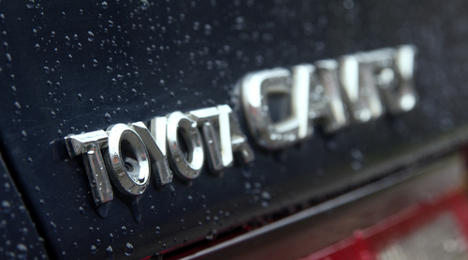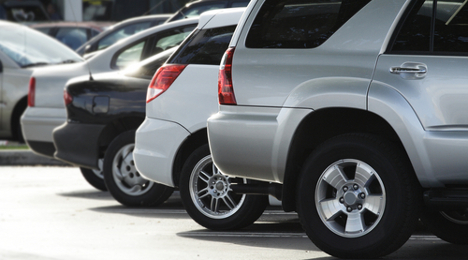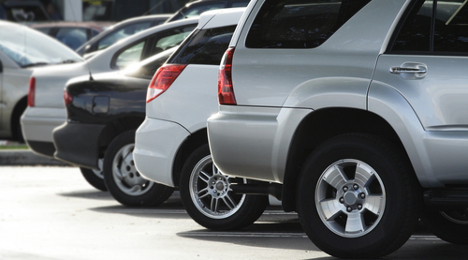In the last seven years, the average age of vehicles on the road in the U.S. increased by 15 percent to 11.5 years.
How will that rate change in the next five years? According to Mark Seng, the global aftermarket practice leader for IHS Automotive, the company’s prediction is an increase in overall average age of about 3 percent by 2020.
While that may not sound like a lot, where dealers can make strategic moves to position themselves for maximum potential profit is to look at which segments will see the biggest growth.
According to IHS, by the year 2020, the segment of vehicles aged zero to 5 years will see the biggest growth – a predicted jump of 24 percent. The volume of vehicles over 12-years-old is expected to increase by 15 percent, while the 6- to 11-year-old segment is anticipated to see a decrease of 11 percent.
If you’re not catching on already, why is this good for you? For one, those older cars will need to be worked on. Therein lies an opportunity for service of all kinds. IHS predicts that the vehicles in operation that are 16-years-old or older will number at approximately 76 million — quite the jump if you consider there were just 35 million vehicles in that age range in 2002.
Talking at the Automotive Aftermarket Products Expo in Las Vegas on Wednesday, Seng says the most successful companies will be those that take advantage of the age shift.
“The aftermarket may need to begin thinking differently about the repair ‘sweet spot’ as vehicles age and consumer behaviors change. Success will require that businesses adapt to the evolution in a timely manner,” Seng said. “Nimble aftermarket organizations that embrace and prepare for the changes underway will have the greatest opportunity to succeed moving forward.”
Segment shifts more toward imports and crossovers?
Looking at U.S. light vehicle sales, IHS points out the dominance sales of compact CUVs, traditional mid-size sedans, traditional compacts and full-size pickups, which, together, made up over 58 percent of new-vehicle registrations made last year. The company anticipates that the CUV phenomenon will continue in the near term while compact and mid-size sedans will continue to maintain popularity.
Import vehicles currently represent a 27.3 percent share of vehicles in operation in the U.S. IHS expects that percentage may jump to 47 percent by 2020. Imported light trucks have seen a 10 percent jump in share since 2007, now currently representing 15.7 percent of the VIO in the U.S.
Also since 2007, the share of domestic cars has decreased by 2 percent, to 37.4 percent of vehicles in operation, while domestic light trucks represent 19.6 percent, down nearly 8 percent since 2007.
IHS also estimates that nearly 60 percent of light vehicle production will be built on global platforms, giving companies another opportunities to know what to expect and prepare in terms of parts and service.
The Trade-In Marketplace will soon have a new name, and with that, an entirely new experience for consumers and toolset for dealers.
The program is being converted into “Kelley Blue Book Instant Cash Offer” during the fourth quarter, Cox Automotive Media Group leadership told a gathering of media on Thursday at its Atlanta headquarters, and the transition is expected to be completed by the end of December.
This follows extensive testing on both the KBB and Autotrader websites, which has uncovered has provided a great deal of insight.
Scott Ehlers, the group’s vice president of product, said that “we know now how to best position this” for both dealers and consumers, alike.
“We do a lot of research. We’ve done more research in the last year and testing in market than we ever have before,” Ehlers said. “So, the product that will actually come to bear in the market will be better tested and actually better positioned, we believe.”
One point of research: the new name, itself, paints a better picture of what the tool actually does: “Get to the instant cash offer. Let’s call it what it is,” Ehlers said. “Better alignment, less questions.”
Cox Automotive Media Group president Jared Rowe followed up, emphasizing how the aim is to push “high-quality” traffic to dealerships, which the company believes should be the “center of the disposal process.”
“When one of your sister companies is one of the largest remarketers in the world, it really is useful and you think about doing these sorts of things,” Rowe said. “Because what it does is, it positions us to help our clients in a way that we don’t think others are positioned, because this ultimately about driving high-quality showroom traffic into our retailers.”
That traffic could come in a couple of different forms, he explained.
First, he said, is the customer who wants to trade-in their vehicle and buy another car. There’s also the consumer who might not need another car, but simply needs to get rid of his or her existing ride — that, in and of itself, is a point of “access to inventory” for dealers, who perhaps are already scouring Craigslist or local newspapers for consumers trying to sell their car.
“And the second thing is, while I may not think I want to buy another vehicle, it’s at least an at-bat,” Rowe said, with the nicely timed baseball analogy.
“You’ve got somebody who’s showing up that you have an opportunity to build a relationship with in some way shape or form and either sell them another car or position yourself so that you are the retailer of choice in the future, because the experience was so good when they needed to dispose of their vehicle,” he added. “But again, we think that it’s important to put the dealer at the center of the disposal process.”
'Liquid cash offer with context'
But as mentioned earlier, it goes beyond a name change. For example, Rowe said, the company has “rationalized the values.”
While the consumer is certainly trying to determine what his or her car is worth, he or she is also seeking to have “confidence” in the actual value, Rowe said. The consumer is provided “market context” through what KBB offers.
“You’re seeing us put the range inside (the offer), next to the Trade-In Marketplace value. So, it’s not just a liquid cash offer; it’s a liquid cash offer with context, which is incredibly important,” Rowe said. “Because if we provide context, it helps set the consumer up for the right conversation. It means the retailer is starting from a slightly different place when they have the conversation with the consumer about what the value of the vehicle is, because ultimately, there still is a condition assessment when the consumer brings the vehicle in.”
Another change is that the company has “optimized the funnel” by reformatting the questions in the vehicle condition quiz for consumers. The questions were rephrased to be “more intuitive” for the shopper.
The company also added some education elements to the overall experience to help set the expectation properly for what the car might be worth.
Using it as trade-in generator
What about dealers who were utilizing the Trade-In Marketplace more as a way to generate inventory?
“We think what drives the traffic – in this case, to get them inventory – is an Instant Cash Offer the customer is going to act on,” said Steve Lind, executive vice president of operations for the group.
He says the experience and the vehicle value provided by KBB can help as motivation for the consumer to make that active decision to take their car to the dealership.
From the marketing and advertising vantage point, will the fact that KBB Instant Cash Offer can be a viable way to help generate inventory certainly still be point of emphasis? Will there still be a push for that?
“Absolutely,” Eddie Tyner, the senior vice president of media sales for the group. “We think that that rebranding is going to significantly increase the number of offers we’re able to make, because the Kelley Blue book brand has such strength, and it’s going to lend a lot of credibility to the program.
“And that will be a big benefit to dealers,” said Tyner. “Dealers are excited about the change, and I think they’re going to get a huge benefit from that.”
He added: “I think they’re going to take a lot of the offers, because they’re going to be legitimate offers. But even in those cases where they don’t, the improvement that they will get in terms of people walking through the door — Jared calls them ‘at-bats’ — they will get huge benefits then.”
What cars do owners hold onto the longest?
Besides the fact that vehicles are lasting longer today than ever before, this is a valuable question — a question whose answer could potentially increase service revenues and make valuable trade-in prospects.
iSeeCars.com took a look at over 395,000 used cars from model year 2005, sold by the original owner between January 1 and July 30 of this year, to get a better understanding of what kind of vehicles were reaching the decade mark by these original owners who bought the cars new.
Looking at the iSeeCars chart below, you’ll see the 15 models among the 168 models studied that were kept the longest, all at least 1.5 times or more likely to be held onto than the average vehicle (which came in at 13.5 percent overall).
Top 15 New Cars Owners Hold Onto for 10 Years
| Rank |
Model |
% Original Owners Holding Car for 10 Years
|
Compared to Average |
| 1 |
Honda CR-V |
28.6% |
2.1x |
| 2 |
Toyota Prius |
28.5% |
2.1x |
| 3 |
Toyota RAV4 |
28.2% |
2.1x |
| 4 |
Toyota Highlander |
26.5% |
2.0x |
| 5 |
Honda Odyssey |
25.6% |
1.9x |
| 6 |
Toyota Sienna |
25.4% |
1.9x |
| 7 |
Toyota Camry |
24.4% |
1.8x |
| 8 |
Toyota Avalon |
23.8% |
1.8x |
| 9 |
Honda Pilot |
23.3% |
1.7x |
| 10 |
Honda Element |
23.1% |
1.7x |
| 11 |
Subaru Forester |
22.9% |
1.7x |
| 12 |
Toyota Matrix |
22.6% |
1.7x |
| 13 |
Honda Accord |
22.1% |
1.6x |
| 14 |
Toyota Corolla |
21.5% |
1.6x |
| 15 |
Toyota 4Runner |
21.1% |
1.6x |
| |
Average of All Cars |
13.5% |
— |
Some quick takeaways you’ll notice: they’re all from Japanese automakers. Nine are Toyotas. Five are Hondas. One Subaru.
That’s not the surprise, however, according to iSeeCars.com’s chief executive officer, Phong Ly. The surprise comes from their segment makeup.
Ten out of the 15 vehicles are CUVs or minivans, with four out of the top five falling into either one of those two categories.
"These vehicles tend to be largely family cars, so if people buy these cars when they are just starting their families, it stands to reason that these cars would suit them for many years," Ly said in an analysis of the data.
Another key takeaway, according to iSeeCars, is the weak showing by what they see as the most popular vehicles from the list of fledgling double-digit ownership.
% of Owners Holding Onto Popular Cars
| Model |
% Original Owners Holding Car for 10 Years |
Compared to Average |
| Toyota Camry |
24.4% |
1.8x |
| Honda Accord |
22.1% |
1.6x |
| Honda Civic |
18.2% |
1.3x |
| AVERAGE |
13.5% |
— |
| Chevrolet Silverado 1500 |
13.1% |
1.0x |
| Nissan Altima |
13.1% |
1.0x |
| Dodge Ram Pickup 1500 |
11.7% |
0.9x |
| Ford F-150 |
11.4% |
0.8x |
| Ford Escape |
10.9% |
0.8x |
| Chevrolet Equinox |
10.0% |
0.7x |
| Jeep Grand Cherokee |
9.5% |
0.7x |
The list is especially devoid of one of North America’s favorite vehicle types, the pickups.
"One reason that may be is because these cars are often used as work vehicles, such as in construction,” Ly said. “Work vehicles log many more miles than average, likely requiring them to be replaced sooner.”
On that same note, Ly also speculates that the absence of domestic brands in the most-held-onto group might be a result of them not having the same reputation for reliability that the Japanese brands typically garner.
The bottom of the overall list is riddled with domestic vehicles that are typically known for their use in commercial fleets or as rental vehicles, including the Chevrolet Impala, Chrysler Sebring and the Ford Taurus, or vehicles that make popular lease choices, like the BMW 5 Series.
"All of those markets are designed for cars that are no more than a few years old, so a decade after these 2005 cars were introduced, most of them would be sold by their second or third owners, rather than the original owners,” Ly said.
According to Ly, car shoppers can sometimes find the most value in these older vehicles that have been kept by a single owner.
"Cars kept by the original owners for a decade tend to be well-cared-for, in terms of actual maintenance and repairs as well as overall cleanliness, so a car shopper is likely to find more value than in a car that has been through multiple owners and with a history that may not be so straightforward,” Ly said.
It seems consumers were looking forward toward the winter-weather months when August rolled around. Medium- and heavy-duty pickup trucks were in high demand last month, and supply is waning.
That's according to the latest installment of Autotrader Scarcity Data Analysis provided to Auto Remarketing that covers supply and demand of certified pre-owned and late-model used vehicles.
In August, two CPO models — the GMC Sierra 2500 at No. 7, and the Ford F-250 at No. 8 — appeared on the national Top 10 list of most shopped certified models with the lowest supply.
Autotrader senior analyst Michelle Krebs pointed out, “Strong overall truck sales, and interest in heftier trucks, are an economic indicator suggesting a healthy construction and house-building market.”
And this bodes well for the truck market going forward.
“Autotrader analysis clearly shows pickup truck sales correlate perfectly with housing starts, but in this recovery, pickup truck sales have actually been ahead of housing starts. The fact that housing starts are picking up indicates there’s a good future for higher pickup truck sales, new and used,” Krebs continued.
Interestingly, though truck interest is growing, sport and luxury cars still made an impressive showing in August, as well.
For example, Krebs pointed out since the newest Mazda MX-5 Miata generation just went on sale, this move is still generating interest for pre-owned models, as well.
The CPO Mazda Miata came in at No. 10 on the national list. That said, this was down seven spots from July results.
Additional sport and luxury cars continue to be in high demand, as well.
“The Porsche brand remains hot, and performance cars continue their comeback,” Krebs said.
Last month, Porsche claimed the No. 1 spot on the certified national scarcity list with its CPO Boxter, which was up three spots from July. The used late-model national list had the Porsche Cayman at No. 2 for August, with the Boxter in the No. 9 spot.
The CPO Boxter was also scarce in Atlanta, where it came in at No. 2.
Audi models continue to be in high demand and low supply, as the CPO Audi S4 came in at No. 2 on the national list. Krebs noted, this model, “along with a lot of other Audi models, are a constant on the CPO scarcity list.
“Audi is a popular brand with younger buyers and particularly millennials, who are likely looking at pre-owned vehicles as more affordable,” she said.
The CPO S4 also notched the No.1 spot in Atlanta and Los Angeles. And for late-model used, the Audi Q3 came in at No. 7.
Lastly, Subaru’s sportier models continue to turn heads, especially the WRX and BRZ, which remained scared in August.
The WRX came in at No. 3 on the CPO national scarcity list, followed by the BRZ.
The CPO WRX also claimed the No. 1 spot in New York, Philadelphia and the San Francisco area, according to Autotrader data.
On the late-model used national scarcity list, the BRZ came in at No. 8, followed by the WRX in the No. 10 slot.
See below for the full August late model used and certified scarcity charts from Autotrader.com:

CarMax president and chief executive officer Tom Folliard likes how the company is positioned to take advantage of the swelling projection of off-lease vehicles expected to fill the auction lanes next year and beyond.
During the company’s most recent conference call, Folliard was asked to compare how CarMax will leverage this chance as compared to a decade ago when the off-lease vehicle market jumped by these expected levels. To recap, Used Car Week featured speaker Joe Derkos, director of the Power Information Network, a division of J.D. Power and Associates, placed his expectations of around an 800,000-unit increase in lease maturity wholesale volume in 2016.
“In terms of our capabilities, we are much more organized today than we were 10 years ago,” Folliard said. “We’re much more analytical about the way we approach car buying at the auction, and I think we’re in a better position today to optimize the inventory that we acquire at the auction because of all the analytics that we’ve put into it and all the digital capabilities that we’ve given our buyers.
“Our buyers are now all using tablets at the auctions,” he continued. “We’re tracking every single car that a buyer at CarMax looks at while at the auction and deciding whether or not that car is worthy. Then the next time a buyer goes to the auction, they don’t have to look at that same car and we’re saving an enormous amount of time in evaluating cars at the auction.
“We have all the auctions on a program where the CarMax buyers are buying under one kind of generic card, and we can analytically decide where those cars go later,” Folliard continued.
That strategy for acquiring inventory evidently is appealing to CarMax buyers. Company dealerships turned 156,516 units during Q2 and 321,026 units at the halfway point of its current fiscal year. Both figures represented a 9.2-percent gain year-over-year.
And it appears CarMax will continue to have buyers in the lanes securing inventory for the company’s network of dealerships, which is expected to expand by 14 during its current fiscal year and by 13 to 16 stores in each of the following two fiscal years.
“If you back up 10 or 15 years, we used to buy on a store-by-store basis, so I’m really pleased with the progress we’ve made in our ability to analyze and purchase inventory,” Folliard said.
“I really do think that leasing provides a more organized way because you’ll see a lot of the big leasing companies will run hundreds and hundreds of cars a week on a very regular basis at the auction,” he continued. “It’s pretty predictable and we have the ability to look at that inventory in advance and decide which ones we are or are not going to bid on.”
Following AutoNation’s strategy
Earlier this month, AutoNation made a major procedure change, announcing a policy not to sell, lease or wholesale any new or used vehicle that has an open safety recall.
The dealer group indicated this policy will apply to each one of AutoNation's 293 vehicle franchises across the United States and stands as a “confirmation of the company's commitment to delivering a peerless customer experience.”
In light of CarMax having the same kind of footprint, Wall Street observers asked Folliard if a similar pivot was in the works regarding recalled units. Folliard explained how CarMax is in the different position than AutoNation, which has a wide array of franchised stores to handle recall repairs. Meanwhile, CarMax only has two franchised dealerships in its entire portfolio, a pair of Toyota rooftops.
So as large as CarMax is, Folliard reiterated that it has to get recall work completed just like the smallest independent dealer — send that vehicle to the appropriate franchised store.
“Well, it is a concern. We’ve talked about it at length,” Folliard said about recalled vehicles. “It’s something that we’re always trying to do what’s the most transparent thing that we can do for our customers.”
“We think the most important thing is to make sure that customers are fully informed of whether or not there’s an open recall on the car and also how important it is to register on a manufacturer’s website. We may sell them a car and a week later a recall may come out, and if they haven’t registered with the manufacturer, then they won’t ever know about that,” he continued.
“Every customer that buys a car at CarMax is made aware in several different points of the transaction about recalls,” Folliard went on to say. “We have a direct link on our website to the NHTSA database. It automatically populates the VIN for the customer so they can see exactly what’s going on with that individual car, and then at the point of sale our sales consultants are walking through with the customer exactly what I just said — whether or not the call has a open recall, and the importance of registering with the manufacturer on their website so they can be notified of recalls going forward.”
CarMax hiring for more than 2,000 positions
In other company news following its Q2 financial performance update, CarMax indicated that it is recruiting for more than 2,000 positions in locations across the country. Officials mentioned the majority of open positions are in service operations (detailers, experienced technicians) and sales, with additional positions in purchasing and the business office. Positions range from full and part-time, with day and evening shifts available.
“Behind every CarMax stress-free customer experience is a dedicated, hard-working team of associates,” Folliard said. “We place a strong focus on providing developmental opportunities for everyone in the company, and on taking care of our associates by offering a healthy work-life balance and excellent benefits.”
Some of the areas with a large number of service job openings include:
— Austin, Fort Worth and Houston, Texas
— Laurel, Md.
— Memphis, Tenn.
— Greensboro, N.C.
— Lancaster, Pa.
— Parker, Colo.
— Louisville, Ky.
— Newark, N.J.
In addition, CarMax is currently hiring for its first Boston-area stores in Danvers, Mass., and Norwood, Mass., which will open in December.
CarMax offers a comprehensive benefits package including health coverage, paid time off, insurance and disability, and retirement options for full-time associates. The company also offers competitive pay and promotes a diverse work environment. Stores are equipped with climate controlled, state-of-the-art service bays with quality equipment. Employees receive discounts on vehicle purchases and other services.
“Our associates experience a workplace full of opportunities for skill development, award-winning training, advancement, and recognition for performance,” said Tracey Shoemaker, director of talent acquisition for CarMax.
“Team-oriented, dependable candidates who are ready to join the CarMax family should apply now,” Shoemaker continued.
For the first time in 2015, monthly auction volume was down on a year-over-year basis. That’s according to the latest Economic Dashboard from the National Auto Auction Association released Monday.
Citing AuctionNet data, the report indicates that August auction volume was down 2.0 percent against comparable weeks of 2014. However, year-to-date volume is still up 6.3 percent, according to the report compiled by NAAA economist Ira Silver.
Auction volume had risen in each of the first seven months of 2015, including a 10.7-percent jump in January to get the year rolling, and an 8.3-percent gain in June.
Also released Monday was the latest Guidelines report from NADA Used Car Guide, a division of J.D. Power.
That report found that August auction volume for vehicles up to 8 years old (which it pegged at 291,000 units) was off 8 percent month-over-month and fell 6 percent year-over-year.
NADA Used Car Guide’s Jonathan Banks said in the report that a “portion of August’s pricing strength can likely be traced to lower auction supply.”
Interestingly enough, the Guidelines report notes that not a single model-year showed a month-over-month increase in August. In fact, the 2015 model-year group had been showing steady gains before August, but ended up down 10 percent from July.
Similarly, there was an average dip of 12 percent for model-years 2012 and 2013 units, while model-year 2014 volume fell 3 percent month-over-month and older model years showed a 5-percent dip, on average.
NADA Used Car Guide found that year-to-date auction volume for vehicles up to 8 years old is 6 percent ahead of where it was last year, having reached 2.81 million units through August.
The effects of increased supply are starting to become more evident in the wholesale market.
Commenting on the first year-over-year decline in used-car prices in a year, ADESA’s Tom Kontos said in his latest Kontos Kommentary report: “We now see a clearer picture of the downward pressure that supply growth is putting on prices.”
The picture for August was this: average wholesale prices were off 0.2 percent at $9,575.
This marks the first year-over-year dip since last August, Kontos said in the report recapping ADESA Analytical Services' monthly analysis of wholesale values.
Pricier, late-model off-rental program vehicle sales have slowed down from once-high levels, Kontos added. So that means the year-over-year comparison, at least when it comes to the makeup of seller types, can be viewed with “more of an apples-to-apples” lens.
Offering its take on auction volume, Kelley Blue Book analysts point out in a recent report that auction lane volume jumped 5 percent (or, put another way, more than 23,000 units) on a month-over-month basis in July.
KBB also mentions in the Blue Book Market Report that there has been a steady uptick in auction volume since June.
“In August, Kelley Blue Book field analysts reported seeing approximately a 25- to 30-percent decrease in auction volumes for General Motor vehicles as well as German manufacturers BMW and Mercedes-Benz,” KBB says in the report.
“The decrease in the volumes for these manufactures likely is due to the holding of inventory in an effort to not oversaturate the market with vehicles in an effort to maintain vehicle value levels,” analysts added. “Conversely, field analysts have reported a spike in Land Rover vehicles throughout the auction lanes this past month, which may be linked to an oversupply in inventory of particular models at the moment.”
According to the most recently updated Economic Dashboard from the National Auto Auction Association, auction volume was up 7.7 percent in July (against comparable weeks of 2014), with the year-to-date increase at 7.4 percent.
Impact of incentives on price
Going to back to his monthly report, Kontos also touches on another factor that has worked in conjunction with increased supply to help drive down price: “Moreover, though retail used-vehicle demand has been strong, average new-car incentives have been climbing, which puts further downward pressure on used-vehicle prices. These impacts are most evident in car prices, as truck prices have held up well in the current low fuel price environment.”
Case in point, truck prices were up 9.8 percent year-over-year in August and car prices were down 5.2 percent. Crossover prices were down 5.1 percent.
With their values down 10.5 percent, entry-level cars have shown the most depreciation of any segment since the beginning of May, according to Black Book. And last week, that downhill movement only continued.
So, given how the supply of off-lease and rental cars is ramping up at auctions — which could potentially drive these prices down further — these soft entry-level car prices are worth monitoring, Black Book says.
Entry-level car values were off 0.93 percent ($61) last week, the company noted, meaning this segment was the biggest decliner among the 24 that Black Book tracks.
“The entry-level car segment continues to drop lower even after experiencing the most depreciation in the last four months,” Anil Goyal, vice president of automotive valuation and analytics, said in Black Book’s latest Used Car Market Insights report.
“It will be interesting to see trends on late-model vehicles as more off-lease and rental cars are beginning to show up at auctions,” he added.
For instance, take this comment Black Book personnel gathered from a Texas man in the lanes last week: “More and more rental cars are showing up in this area. We should see what impact this has over the next few weeks.”
After nearly 8-percent year-over-year growth in the second quarter, auction volume through the first half of 2015 stands 7.3 percent ahead of the levels reached in the opening six months of 2014.
That’s according to AuctionNet data cited by the NAAA’s latest Auction Industry Report.
The report, compiled by NAAA economist Ira Silver, indicates that auction volume climbed 6.9 percent in the first quarter of this year, which was followed by 7.8-percent growth in Q2. (In all of 2014, auction volume climbed 4.9 percent, according to the report).
In the second quarter of 2015, specifically, commercial consignment was up 11.2 percent. Meanwhile, dealership consignment climbed 5.0 percent.
Year-to-date, commercial volume has jumped 10.3 percent, with dealer volume up 4.8 percent.
“The relative strength in commercial consignment is related to the high growth in new sales in past years,” Silver said in the report. “Dealer consignment is increasing at a lower rate than commercial consignment due to its dependence on current new-vehicle retail sales, which are growing at a slower rate than they were in the early stages of the recovery.
“This pattern of relatively strong commercial consignment is likely to continue for at least the next year,” he continued.
Turning to vehicle types, Silver added: “Passenger car auction volume growth continued to outpace light truck volume performance, a trend that began last year.”
Specifically, passenger car volume was up 8.3 percent in Q2, with the year-to-date gain at 8.8 percent. Light truck volume was up 7.3 percent in the quarter and 5.7 percent year-to-date.
As used-vehicle prices fell by 2.2 percent last month from June rates, according to NADA Used Car Guide data, auction volume was on the way down as well.
According to NADA UCG’s latest Guidelines report, auction volume of models up to 8 years old reached nearly 310,000 units in July.
This marked a 6-percent decline from June’s total. The report stated volume was lower across all models years, except for one: 2015, which jumped by 56 percent from June to 27,500 units.
This is perhaps not surprising news to the industry as dealers try to make room for 2016 models set to hit the lots in the coming months.
NADA UCG pointed out that while the number of 2015 model-year vehicles at auction continues to soar, the opposite is true for 2014 models.
For the 2014 years, auction volume dropped by 12 percent last month to 46,000 units, while supply for 2012 and 2013 models fell by an average of 13 percent to 54,000 and 50,000 units, respectively.
Depreciation for 2007 to 2011 models was a bit less dramatic, as these models’ volume fell by a range of 4 percent to 8 percent.
Taking July’s volume drops into account, auction volume year-to-date stands at 2.51 million units, or 7 percent more than last year’s seven-month total, according to the report.
NADA UCG also took a look at late-model vehicles, specifically, or those used vehicles up to 5 years old.
Year-to-date auction volume growth has been driven in part by subcompact cars, which leads the pack with volume up by 58 percent, representing 5 percent of total auction volume. Large cars (6 percent of auction volume) and large pickups (9 percent of auction volume) are also seeing numbers expand, by 39 percent each, to be exact.
“Compact and midsize cars continue to dominate auction volume where share sits at 17 percent and 21 percent, respectively,” Jonathan Banks, executive automotive analyst for NADA UCG, said in the report. “Compact car volume is up 26 percent year-to-date, while midsize car volume is up 5 percent. Compact utility volume is up 7 percent, and overall share stands at 12 percent.”
With this auction volume movement in mind, NADA UCG is predicting wholesale prices will fall by 2.2 percent to 2.7 percent in August, compared to July rates.
“This year’s anticipated rate of depreciation would be marginally better than the nearly 3 percent decline recorded in August 2014, but somewhat steeper than the roughly 2 percent decline averaged in the two years prior,” Banks said.
Following recent trends, subcompact cars are expected to see the most significant depreciation this month, followed by compact and midsize cars.
“Losses for the group should exceed the high end of our overall forecast, while utility, van, and pickup depreciation should be near-to, or below the low-end. Luxury vehicle losses should be similar to those of mainstream cars,” Banks shared.













